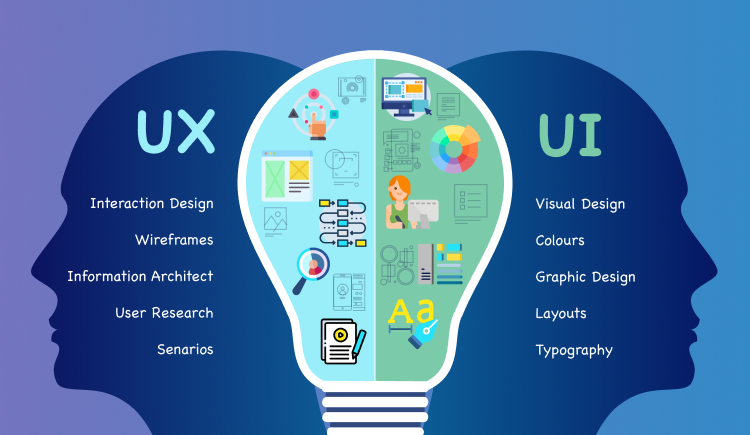Table of Contents
Introduction
In today’s digital age, user experience (UX) and user interface (UI) design are crucial for the success of any online product. Whether it’s a website, an app, or a digital service, the design determines how users interact with the technology. If you’re considering a career in this dynamic field, a UI/UX designer course can set you on the right path. This article will explore what UI/UX designer courses entail, their benefits, real-life examples, and provide a comprehensive learning plan.
What is UI/UX Design?
UI (User Interface) design focuses on the look and layout of a product. This includes buttons, icons, spacing, typography, colors, and responsive design. It’s all about aesthetics and ensuring the interface is visually appealing and easy to navigate.
UX (User Experience) design, on the other hand, is about enhancing user satisfaction by improving the usability, accessibility, and pleasure provided in the interaction with the product. UX designers conduct user research, create personas, and develop wireframes and prototypes to ensure the product meets the needs and expectations of users.
Importance of UI/UX Design
Imagine visiting a website that takes forever to load, has cluttered navigation, and a confusing checkout process. Chances are, you won’t stay long. Poor design can drive away potential customers. Conversely, a well-designed product can enhance user satisfaction, increase engagement, and boost conversions.
Real-Life Examples
Airbnb: Airbnb’s success can be largely attributed to its user-centric design. The platform is easy to navigate, visually appealing, and simplifies the process of booking a stay. Their user research revealed the importance of high-quality images and detailed descriptions, which are now integral to their UI design.
Spotify: Spotify offers a seamless user experience across devices. Their design allows users to easily search for songs, create playlists, and discover new music. The intuitive interface and personalized user experience have made Spotify a leader in the music streaming industry.
Benefits of a UI/UX Designer Course
- Comprehensive Skill Set: UI/UX designer Courses cover a range of topics from user research, wireframing, and prototyping to visual design and usability testing.
- Hands-On Experience: UI/UX designer courses include projects that allow you to apply what you’ve learned in real-world scenarios.
- Portfolio Development: By the end of the UI/UX designer course, you’ll have a portfolio showcasing your design skills, which is essential when applying for jobs.
- Career Opportunities: UI/UX design skills are in high demand across various industries, including tech, finance, healthcare, and retail.
Learning Plan for Aspiring UI/UX Designers
The world of online learning platforms offers a vast selection of UI/UX design courses. Here are some well-regarded options to consider for your learning plan, categorized by level:
Beginner:
- Google UX Design Certificate (https://grow.google/certificates/ux-design/): This beginner-friendly UI/UX designer course from Google provides a solid foundation in UX design principles, user research, prototyping, and design thinking. It’s a great option for those with no prior design experience.
- The Interaction Design Foundation (https://www.interaction-design.org/): This platform offers a comprehensive library of free UI/UX design courses, covering various topics like user research, usability testing, and design for accessibility.
Intermediate:
- UI/UX Design Specialization by California Institute of the Arts (CalArts) (https://www.coursera.org/specializations/ui-ux-design): Offered on Coursera, this specialization delves deeper into UI design elements, UX research methods, and prototyping tools like Figma.
- Introduction to UI and UX Design by Codecademy (https://www.codecademy.com/resources/docs/uiux) : This free course from Codecademy provides a good starting point for understanding the core concepts of UI and UX design.
Advanced:
- UX/UI Design Masterclass: From Beginner to UI/UX Designer by CareerFoundry (https://careerfoundry.com/en/courses/become-a-ux-designer/) : This comprehensive UI/UX designer course offered by CareerFoundry provides in-depth training on UI/UX design processes, portfolio development, and interview preparation. It’s ideal for those aiming for a career transition into UI/UX design.
- Specialization in User Interface (UI) Design by University of Michigan (https://www.coursera.org/specializations/ui-ux-design) : This Coursera specialization focuses on the intricacies of UI design, covering visual design principles, typography, and user interface animation.
Continuous Learning
- Stay Updated: UI/UX design is a constantly evolving field. Follow design blogs, join communities, and participate in webinars to stay updated with the latest trends and technologies.
Final Thoughts
Embarking on a UI/UX design course is a step towards a fulfilling and lucrative career. With the increasing demand for digital products, the need for skilled UI/UX designers is more significant than ever. By understanding the importance of design, learning the necessary skills, and continuously updating your knowledge, you can create products that not only meet user needs but also stand out in the market.
Start your journey today and transform the way users interact with technology through exceptional design. Happy designing!

Frequently Asked Questions About UI/UX Designer Courses
If you’re considering a career in UI/UX design or looking to enroll in a UI/UX designer course, you likely have many questions. Below, we’ve answered some of the most frequently asked questions to help you make an informed decision.
What Qualifications Do I Need to Be a UI/UX Designer?
Becoming a UI/UX designer does not necessarily require a specific degree, but there are certain skills and qualifications that can enhance your career prospects:
- Educational Background: Degrees in design, computer science, psychology, or related fields can be beneficial.
- Technical Skills: Proficiency in design software such as Adobe XD, Sketch, Figma, and prototyping tools.
- Portfolio: A strong portfolio showcasing your design projects and skills.
- Soft Skills: Strong communication, problem-solving, and empathy are crucial for understanding and addressing user needs.
- Certifications: Completing a UI/UX designer course can provide you with the necessary skills and credentials.
What is the UI/UX Design Course For?
A UI/UX designer course is designed to equip you with the skills needed to create intuitive and engaging user interfaces and experiences. The course typically covers:
- User Research: Understanding user needs through interviews, surveys, and usability testing.
- Wireframing and Prototyping: Creating wireframes and interactive prototypes to visualize design concepts.
- Visual Design: Learning about color theory, typography, layout, and visual hierarchy to create aesthetically pleasing designs.
- Usability Testing: Conducting tests to gather feedback and improve design.
- Accessibility: Ensuring designs are accessible to all users, including those with disabilities.
- Portfolio Development: Building a professional portfolio to showcase your skills to potential employers.
Can I Learn UI/UX in 3 Months?
Yes, it is possible to learn the basics of UI/UX design in 3 months, especially if you are dedicated and follow a structured learning plan. Here’s a suggested 3-month learning plan:
Month 1: Foundations
- Understand the fundamentals of UI/UX design.
- Learn about design principles, color theory, and typography.
- Start with basic wireframing and prototyping.
Month 2: Practical Application
- Conduct user research and create user personas.
- Work on real-world projects to apply your knowledge.
- Develop your skills in visual design and interaction design.
Month 3: Advanced Techniques and Portfolio
- Focus on usability testing and accessibility.
- Refine your projects and create a professional portfolio.
- Prepare for job applications and interviews.
What is UI/UX Design Salary?
The salary for UI/UX designers can vary based on factors such as experience, location, and the specific industry. Here are some general insights:
- Entry-Level: Junior UI/UX designers can expect to earn between $50,000 and $70,000 annually.
- Mid-Level: Designers with 3-5 years of experience can earn between $70,000 and $100,000.
- Senior-Level: Experienced designers and design leads can earn upwards of $100,000, with some reaching $150,000 or more.
- Freelance: Freelancers can set their own rates, often charging between $50 to $150 per hour depending on their expertise and client base.
Salaries can also vary significantly by location. For example, UI/UX designers in tech hubs like San Francisco, New York, and Seattle tend to earn higher salaries compared to those in smaller cities.




3 Pingbacks